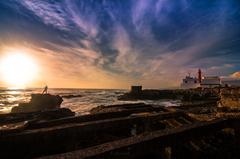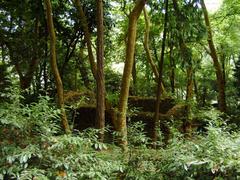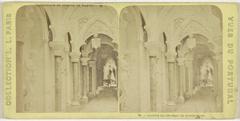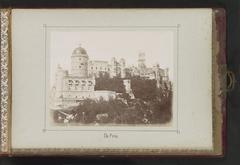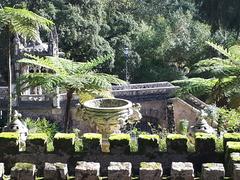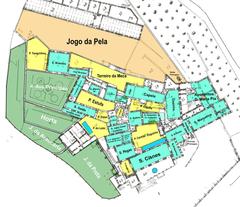Palácio E Quinta Do Ramalhão, Também Denominado «Paço Real Do Ramalhão» (Actualmente Colégio De São José Das Irmãs Dominicanas Portuguesas)
Palácio e Quinta do Ramalhão: Visiting Hours, Tickets, and Sintra Historical Sites Guide
Date: 15/06/2025
Introduction
Nestled in the enchanting landscape of Sintra, Portugal, the Palácio e Quinta do Ramalhão stands as a testament to centuries of royal heritage, neoclassical architecture, and aristocratic garden design. With origins tracing back to the late 15th century, the estate evolved from a rural property to a summer retreat for the Portuguese nobility, and later, a residence and place of exile for Queen Carlota Joaquina in the early 19th century. Although today the palace serves as the Colégio de São José das Irmãs Dominicanas Portuguesas—limiting public access to its interiors—its striking neoclassical façade and surrounding gardens remain visible and evocative of Sintra’s historical richness. This guide explores the estate’s history, architecture, artistic highlights, practical visitor information, and its role within Sintra’s broader cultural landscape (Jardins Históricos; Wikipedia EN; All About Portugal; Sintra Portugal Tourism).
History and Evolution
Early Origins and Development
The estate’s documented history begins in 1470, when King Afonso V granted the land to nobleman Diogo Gomes, stipulating cultivation and feudal obligations (Jardins Históricos). Over the following centuries, the property transitioned from a working farmstead to a refined residence, eventually becoming a palatial retreat for the aristocracy (Wikipedia PT).
Architectural Flourishing
The palace’s neoclassical style took shape in the late 18th and early 19th centuries. Its interiors boast Rococo and Louis XVI decorative influences, with frescoes by Jean-Baptiste Pillement and Manuel da Costa. Gilded stuccoes, elegant moldings, and period furnishings reflect the tastes of the Portuguese elite (Wikipedia EN).
Royal Connections
Palácio do Ramalhão is closely associated with Queen Carlota Joaquina, consort to King João VI. Following the political upheaval of the 1820 Liberal Revolution, she was exiled here, turning the palace into a center of political intrigue and historical significance (All About Portugal). The site also attracted intellectuals and artists, including the English writer William Beckford.
Later Use and Conservation
After its royal period, the estate passed through various noble hands before being acquired by the Dominican Sisters in 1941, who established the Colégio de São José in 1942. This adaptive reuse has ensured the property’s preservation and continued relevance. The estate was designated as a Property of Public Interest in 1996, securing its protection (Colégio do Ramalhão; Wikipedia PT).
Artistic, Architectural, and Garden Highlights
Neoclassical and Artistic Features
- Façade and Structure: The palace is a fine example of Portuguese neoclassicism, with harmonious proportions, pilasters, and restrained decorative motifs.
- Interior Decoration: Frescoes by Pillement and Manuel da Costa, Louis XVI-style ornamentation, and azulejo tilework.
- Decorative Arts: Gilded woodwork, hand-painted ceilings, and period furnishings reflect both Portuguese and broader European artistic influences (Wikipedia EN).
Gardens and Landscape Design
- Layout: The gardens combine formal parterres and naturalistic elements, including terraces, fountains, and mature native and exotic plantings.
- Flora: Oaks, laurels, camellias, magnolias, hydrangeas, and productive kitchen gardens adapt to Sintra’s unique microclimate.
- Design Significance: The gardens exemplify the transition from Baroque formality to Romantic landscaping, integral to Sintra’s UNESCO World Heritage designation (All About Portugal).
Practical Visitor Information
Visiting Hours and Tickets
- Regular Access: The palace and gardens are not open for general public visits due to their role as an active school.
- Special Events: Limited access may be possible during heritage days or cultural festivals (e.g., Open House Lisboa, Jornadas Europeias do Património), usually requiring advance booking (Colégio Ramalhão Contact).
- Tickets: No standard ticketing; special event entry is generally free but requires registration.
How to Get There
- By Car: About 30 minutes from Lisbon via A37 (IC19); limited on-site parking.
- Public Transport: Lisbon’s Rossio Station to Sintra (CP Sintra Line); from Sintra station, a short taxi or bus ride to the estate.
- On Foot/Bicycle: Accessible from Sintra town center, but be aware of hilly terrain.
Accessibility
- Interior: Not accessible to the public.
- Gardens: Viewable from adjacent public streets; direct access may be possible during special events.
- Mobility: The historic grounds have uneven paths and steps; limited accessibility for wheelchairs (Wikidata).
Facilities
- Restrooms and Cafeteria: Not available except during organized events.
- Photography: Permitted from public areas; restrictions may apply during events or within the institution.
Nearby Attractions
Sintra’s wealth of historical and natural sites makes it ideal for a multi-site visit. Consider these accessible highlights:
- Palácio Nacional de Sintra: Distinctive chimneys and lavish interiors.
- Palácio Nacional da Pena: Iconic Romanticist palace with panoramic views.
- Quinta da Regaleira: Mystical gardens and architectural wonders.
- Jardins de Monserrate: Exotic landscaping and historic villa.
- Parque da Liberdade: Public park with scenic walks (The Crazy Tourist).
Frequently Asked Questions (FAQ)
Q: Can I visit the interior of Palácio e Quinta do Ramalhão?
A: No, general public access is not allowed except during special events.
Q: Are tickets required?
A: No regular ticketing; access during events is free but requires prior booking.
Q: Is the estate wheelchair accessible?
A: Only partially, and only during special events. The terrain is uneven.
Q: Are there guided tours?
A: Occasionally, during heritage events; typically in Portuguese, with English possible by arrangement.
Q: What is the best way to reach the estate?
A: By train to Sintra, followed by taxi or a 10–15-minute walk; limited parking is available for cars.
Visitor Recommendations
- Plan Ahead: Check with the school or local tourism office for event dates and access details.
- Combine Visits: Pair Ramalhão with open-access sites like Palácio Nacional de Sintra and Quinta da Regaleira.
- Respect the Site: As an active educational and religious space, observe dress codes and institutional rules.
- Best Time: Spring and autumn offer pleasant weather and occasional public events.
- Use Technology: Download the Audiala app for curated audio guides and up-to-date visitor information.
Visual Gallery
Related Articles
Contact and Booking
- Address: Rua Elias Garcia, nº 2, Quinta do Ramalhão, São Pedro de Penaferrim, 2710-703 Sintra, Portugal
- Phone: +351 21 910 75 54
- Email: [email protected]
- Website: Colégio de São José do Ramalhão
Further Reading and Official Sources
- Jardins Históricos - Palácio do Ramalhão, 2024
- Wikipedia EN - Ramalhão Palace, 2024
- All About Portugal - Palácio e Quinta do Ramalhão, 2024
- Colégio do Ramalhão - History, 2024
- Sintra Portugal Tourism - Quinta da Regaleira Guide, 2024
- Sintra Explorers - Sintra Festivals 2025, 2024
- Colégio Ramalhão Contact, 2024
- Wikipedia PT - Palácio do Ramalhão, 2024
Conclusion
Palácio e Quinta do Ramalhão remains a hidden gem for those interested in the layered history and lush landscapes of Sintra. While its interiors are rarely open, the estate’s historical resonance and tranquil gardens can still be appreciated from public vantage points. For a deeper exploration, time your visit with Sintra’s heritage events, and complement your experience with nearby palaces and gardens. Use digital resources and consult with local tourism offices to maximize your cultural journey through Sintra.

